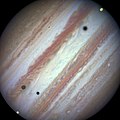Файл:Galilean satellite triple conjunction 2015-01-24 (right).jpg

Төп файл (1000 × 1000 нокта, файл зурлыгы: 584 Кб, MIME төре: image/jpeg)
Бу файл Викиҗыентык проектыннан һәм башка проектларда кулланылырга мөмкин. Файл турында тулырак мәгълүмат түбәндә күрсәтелгән.
Тасвирлама
| ТасвирGalilean satellite triple conjunction 2015-01-24 (right).jpg |
English: Firing off a string of snapshots like a sports photographer at a NASCAR race, NASA's Hubble Space Telescope captured a rare look at three of Jupiter's largest moons parading across the banded face of the gas-giant planet: Europa, Callisto, and Io.
These so-called Galilean satellites (named after the 17th century scientist Galileo Galilei, who discovered them with a telescope) complete orbits around Jupiter ranging from 2 days to 17 days in duration. They can commonly be seen transiting the face of Jupiter and casting shadows onto its cloud tops. However, seeing three moons transiting the face of Jupiter at the same time is rare, occurring only once or twice a decade. The Hubble image on the left shows the beginning of the event, which took place on January 24, 2015. From left to right the moons Callisto and Io are above Jupiter's cloud tops. The shadows from Europa (not seen in the image), Callisto, and Io are strung out from left to right. Near the end of the event, approximately 42 minutes later (right-side image), Europa has entered the frame at lower left. Slower-moving Callisto is above and to the right of Europa. Fastest-moving Io is approaching the eastern limb of the planet; its shadow is no longer visible on Jupiter. Europa's shadow is toward the left side of the image, and Callisto's shadow to the right. (The moons' orbital velocities are proportionally slower with increasing distance from the planet.) Missing from the sequence is the moon Ganymede, which was outside Hubble's field of view and too far from Jupiter in angular separation to be considered part of the conjunction. The moons in these photos have distinctive colors. The ancient, cratered surface of Callisto is brownish; the smooth icy surface of Europa is yellow-white; and the volcanic, sulfur-dioxide surface of Io is orange. The apparent "fuzziness" of some of the shadows depends on the moons' distances from Jupiter. The farther away a moon is from the planet, the softer the shadow, because the shadow is more spread out across the disk. The images were taken with Hubble's Wide Field Camera 3 in visible light. |
|||
| Дата | (released 5 February 2015) | |||
| Чыганак | http://hubblesite.org/newscenter/archive/releases/2015/05/image/b/ and http://hubblesite.org/newscenter/archive/releases/2015/05/image/c/ (see also http://heritage.stsci.edu/2015/05/index.html) | |||
| Автор | NASA, ESA, and the Hubble Heritage Team (STScI/AURA) | |||
| Башка юрамалар |
|
Лицензияләү
| Public domainPublic domainfalsefalse |
| Этот файл находится в общественном достоянии (англ. public domain), так как он был создан NASA (Национальным управлением по аэронавтике и исследованию космического пространства). Политика авторского права NASA гласит, что «Материал NASA не защищается авторским правом, если не указано иное». (См. Template:PD-USGov, страницу политики авторского права NASA или политику использования изображений JPL.) |  | |
 |
Предупреждения:
|
Файл тарихы
Файлның нинди булганлыгын күрү өчен «дата/вакыт» дигәненә басыгыз.
| Дата/вакыт | Кече рәсем | Үлчәмнәре | Кулланучы | Искәрмә | |
|---|---|---|---|---|---|
| агымдагы | 19 фев 2021, 17:02 |  | 1000 × 1000 (584 Кб) | Charlestpt | File:Galilean satellite triple conjunction 2015-01-24.jpg cropped 50 % horizontally using CropTool with lossless mode. |
Файлны куллану
Бу файлны кулланган битләр юк.
Файлның гомуми кулланышы
Әлеге файл аста бирелгән викиларда куллана:
- en.wikipedia.org проектында куллану
- fr.wikipedia.org проектында куллану
Метабирелмәләр
Бу файлда гадәттә санлы камера яки сканер тарафыннан өстәлгән мәгълүмат бар. Әгәр бу файл төзү вакытыннан соң үзгәртелгән булса, аның кайбер параметрлары дөрес булмаска мөмкин.
| Киңлек | 1000 нкт |
|---|---|
| Биеклек | 1000 нкт |
| Төс тирәнлеге |
|
| Кысу ысулы | LZW |
| Төс моделе | RGB |
| Кадр куелышы | Гадәти |
| Төс өлешләре саны | 3 |
| Ятма ачыклык | 72 точек на дюйм |
| Асма ачыклык | 72 точек на дюйм |
| Принцип организации данных | «chunky» форматы |
| Кулланылган программа | Adobe Photoshop Elements 12.0 Macintosh |
| Файл үзгәреше датасы һәм вакыты | 7 фев 2015, 12:31 |
| Exif чыгарышы | 2.21 |
| Төсләр киңлеге | sRGB |
| Дата последнего изменения метаданных | 7 фев 2015, 04:31 |
| Санлаштыру вакыты | 7 фев 2015, 04:26 |
| Уникальный идентификатор исходного документа | xmp.did:767D3918392068118083DF440090DADA |

